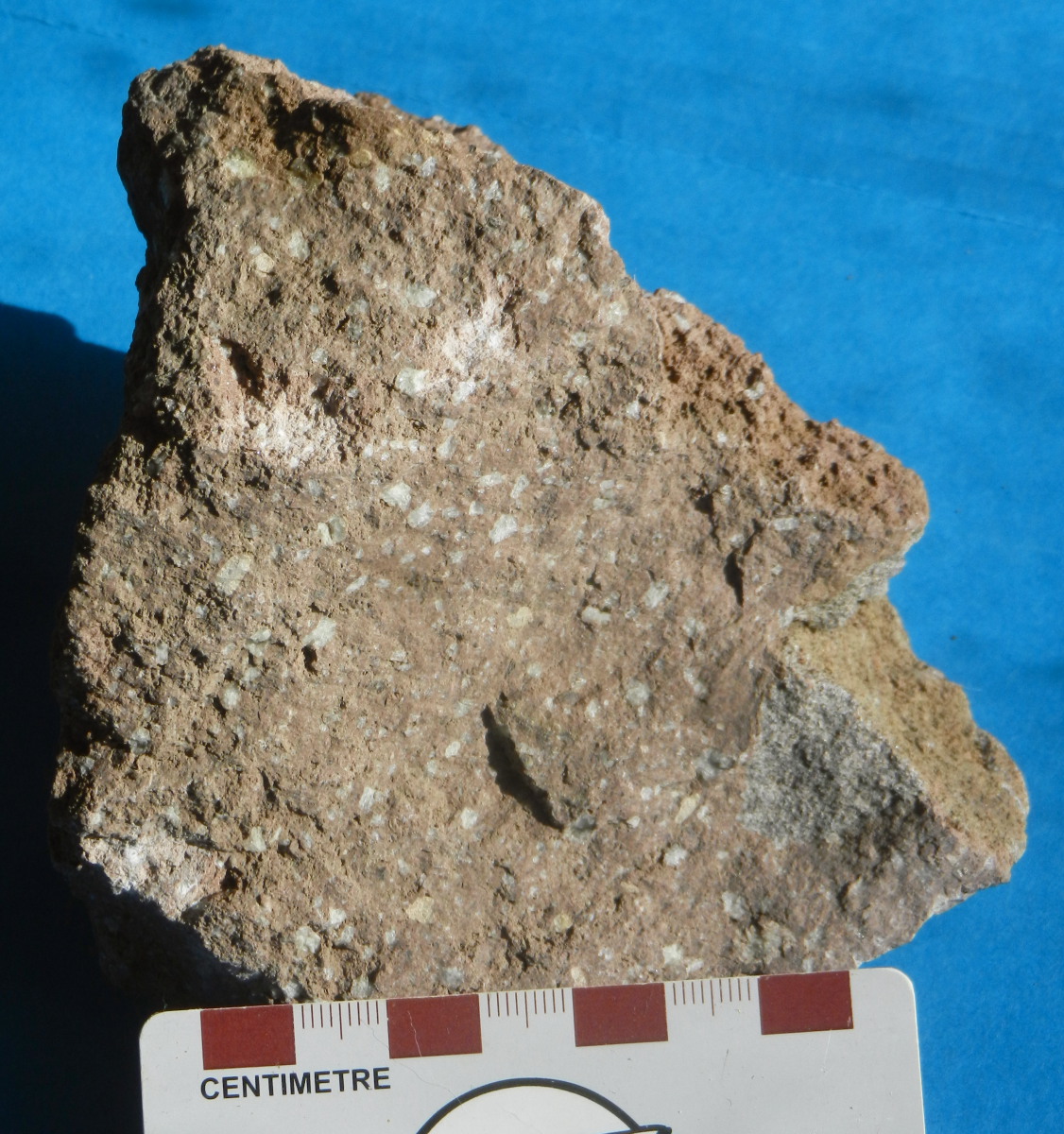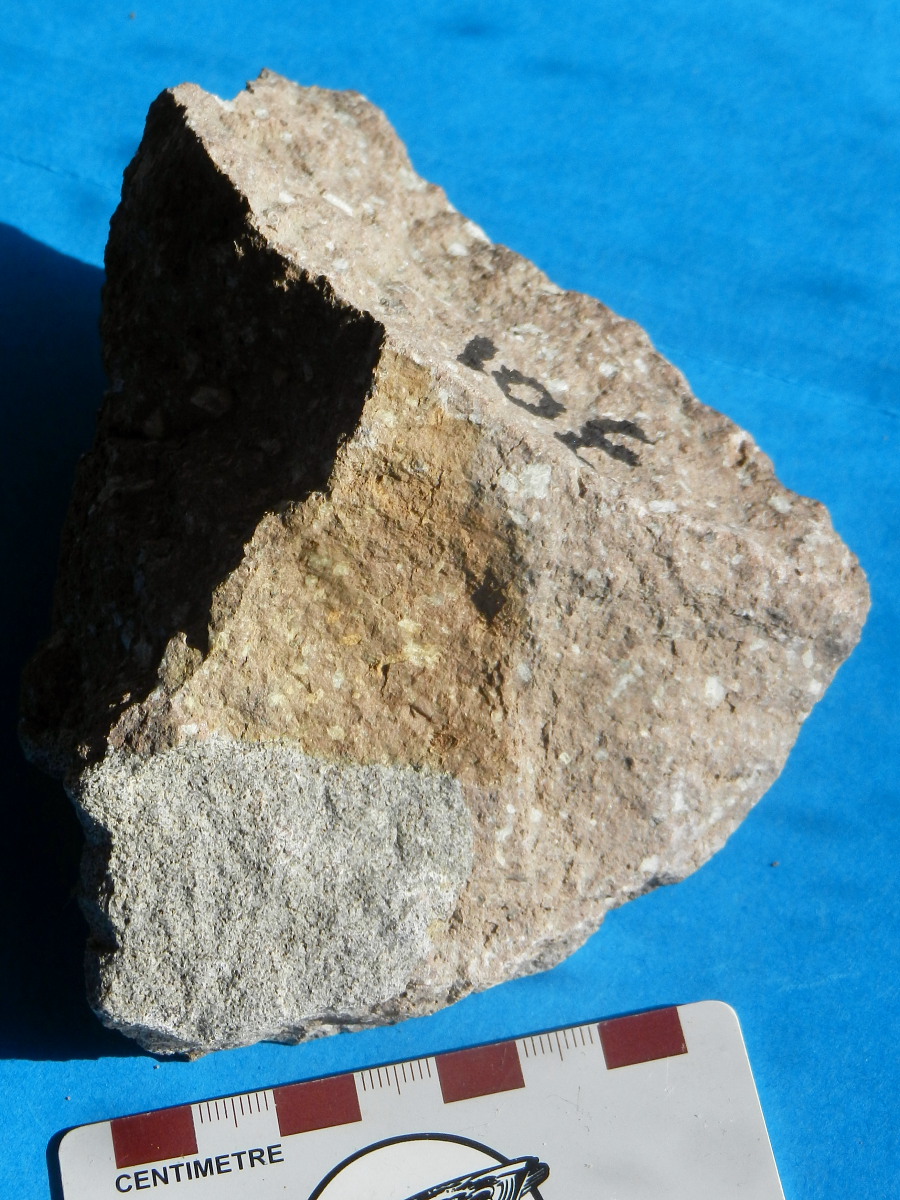"Rock of the Month # 236, posted for February 2021" ---
The four samples illustrated here were collected on an ascent of the volcano on 08 November 1983. 298 and 299 were from the top 100 m of the mountain, 299 collected just above a rock step, below 298, which comes from the top 10 m or so of the volcano. 300 is from the rock step on the ridge. 301 was found by Rod Grover,
below the rock step. The ridge trends NNE from the summit, on the Huamantla side of the peak. All samples collected loose, but "effectively in situ", reprersentative of their immediate surroundings.
Dark glass is seen on some of the material. A covered thin section of 299 reveals that an estimated 58 volume percent of the sample
is a brownish glass, charged with tiny (?) iron-titanium oxide grains. A further 35% of the rock is plagioclase feldspar. There are many phenocrysts (23%) that display oscillatory zonation and multiple twin laws, while 2% are turbid, rounded crystals that may be xenocrysts from an older pulse of magma: these appear partially resorbed by the enclosing melt, and are mantled by thin (0.05 mm) clear rims. 10% of the rock is fine-grained (<0.3 mm) plagioclase in the groundmass. There are masses of Fe oxides, thought to be pseudomorphs after amphibole (7%) and a trace of relict, pleochroic, highly coloured basaltic hornblende (lamprobolite).
La Malinche is a stratovolcano, of Tertiary-Quaternary age, believed now to be extinct.
There are tuff cones on the flanks (Abrams and Siebe, 1994).
The volcano appears in regional descriptions and mapping (UNAM, 1979; Lopez Ramos, 1983).
The large stratovolcanoes in the region (La Malinche, Cofre de Perote and
Orizaba) each represent >100 km3 of lava, and follow the NNW-SSE alignment of the Libres-Oriental graben. Hot rock and waters at depth confer
geothermal energy potential (Romero, 1991). Besides andesites,
there are rhyolite domes, the voluminous Xaltipan ignimbrite (180 km3),
rhyodacites, basaltic andesites and pumice.
Topography and climbing routes are described in mountaineering texts,
such as Secor (1981). The name La Malinche refers to
the "Weeping Woman", a legend dating to the invasion
and colonization of Mexico
by the Spanish conquistadors.
Samples, including 299, were contributed to a study
of radiocarbon production in rocks, induced by cosmic rays at high altitudes
(Wilson, 1987; Jull et al., 1989).
References
Abrams,MJ and Siebe,C (1994) Cerro Xalapaxco: an unusual tuff cone with multiple explosion craters, in central Mexico (Puebla). J.Volc.Geotherm.Res. 63, 183-199.
Jull,AJT, Donahue,DJ, Linick,TW and Wilson,GC (1989) Spallogenic
14C in high-altitude rocks and in Antarctic meteorites. Radiocarbon 31, 719-724.
Lopez Ramos,E (1983) Geologia de Mexico. Vol.3 of `Geologia General y de Mexico', distrib. by UNAM, Mexico, edition 3a, 453pp. (in Sp.).
Romero R,F (1991) Los Humeros geothermal field, Puebla. In `Economic Geology, Mexico' (Salas,GP editor), GSA DNAG volume P-3, 438pp., 77-94.
Secor,RJ (1981) Mexico's Volcanoes: A Climbing Guide. The Mountaineers, Seattle, 120pp.
Universidad Autonoma de Mexico (1979) Puebla y Tlaxcala. UNAM State Map, blueprint format (`heliografica') (1:500,000) (in Sp.) (3rd edition).
Wilson,GC (1987) Untitled (on samples from high altitudes on volcanoes in Mexico, and
carbonaceous sediments from the Sudbury area of Ontario). Technical report, 14pp.,
28 July.
![andesite [381 kb]](http://www.turnstone.ca/lam298b299.jpg)
![andesite [461 kb]](http://www.turnstone.ca/lam300.jpg)
 1
1
